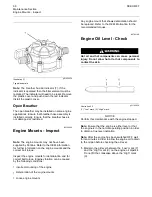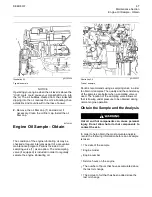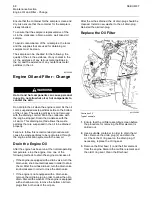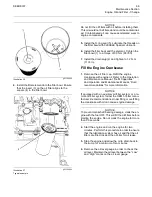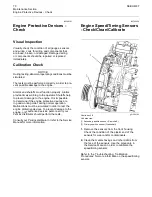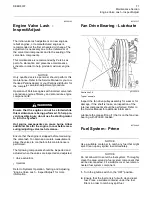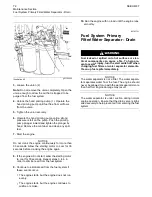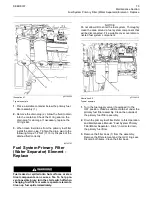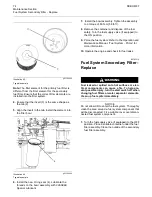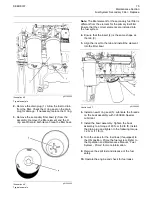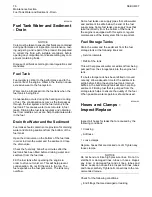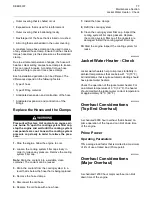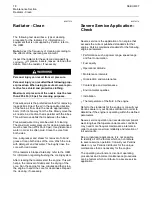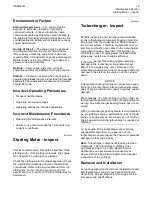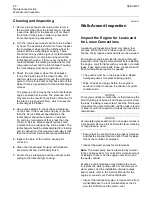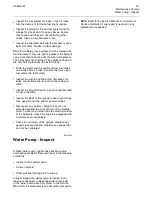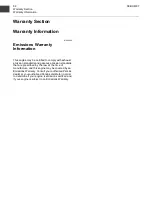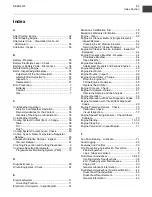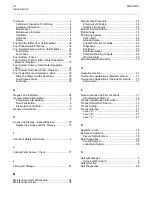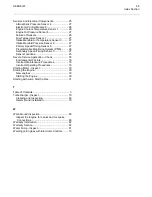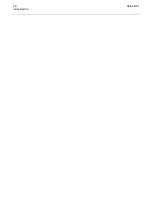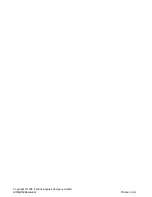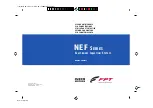
80
SEBU8337
Maintenance Section
Walk-Around Inspection
Cleaning and Inspecting
1.
Remove the exhaust outlet piping and remove
the air inlet piping from the turbocharger. Visually
inspect the piping for the presence of oil. Clean
the interior of the pipes in order to prevent dirt
from entering during reassembly.
2.
Turn the compressor wheel and the turbine wheel
by hand. The assembly should turn freely. Inspect
the compressor wheel and the turbine wheel for
contact with the turbocharger housing. There
should not be any visible signs of contact between
the turbine wheel or compressor wheel and the
turbocharger housing. If there is any indication of
contact between the rotating turbine wheel or the
compressor wheel and the turbocharger housing,
the turbocharger must be reconditioned.
3.
Check the compressor wheel for cleanliness.
If only the blade side of the wheel is dirty, dirt
and/or moisture is passing through the air
fi
ltering
system. If oil is found only on the back side of the
wheel, there is a possibility of a failed turbocharger
oil seal.
The presence of oil may be the result of extended
engine operation at low idle. The presence of oil
may also be the result of a restriction of the line for
the inlet air (plugged air
fi
lters), which causes the
turbocharger to slobber.
4.
Use a dial indicator to check the end clearance
on the shaft. If the measured end play is greater
than the Service Manual speci
fi
cations, the
turbocharger should be repaired or replaced.
An end play measurement that is less than the
minimum Service Manual speci
fi
cations could
indicate carbon buildup on the turbine wheel. The
turbocharger should be disassembled for cleaning
and for inspection if the measured end play is less
than the minimum Service Manual speci
fi
cations.
5.
Inspect the bore of the turbine housing for
corrosion.
6.
Clean the turbocharger housing with standard
shop solvents and a soft bristle brush.
7.
Fasten the air inlet piping and the exhaust outlet
piping to the turbocharger housing.
i02568213
Walk-Around Inspection
Inspect the Engine for Leaks and
for Loose Connections
A walk-around inspection should only take a few
minutes. When the time is taken to perform these
checks, costly repairs and accidents can be avoided.
For maximum engine service life, make a thorough
inspection of the engine compartment before starting
the engine. Look for items such as oil leaks or coolant
leaks, loose bolts, worn belts, loose connections and
trash buildup. Make repairs, as needed:
•
The guards must be in the proper place. Repair
damaged guards or replace missing guards.
•
Wipe all caps and plugs before the engine is
serviced in order to reduce the chance of system
contamination.
NOTICE
For any type of leak (coolant, lube, or fuel) clean up the
fl
uid. If leaking is observed,
fi
nd the source and correct
the leak. If leaking is suspected, check the
fl
uid levels
more often than recommended until the leak is found
or
fi
xed, or until the suspicion of a leak is proved to be
unwarranted.
NOTICE
Accumulated grease and/or oil on an engine or deck is
a
fi
re hazard. Remove this debris with steam cleaning
or high pressure water.
•
Ensure that the cooling lines are properly clamped
and that the cooling lines are tight. Check for leaks.
Check the condition of all pipes.
•
Inspect the water pumps for coolant leaks.
Note:
The water pump seal is lubricated by coolant
in the cooling system. It is normal for a small amount
of leakage to occur as the engine cools down and
the parts contract.
Excessive coolant leakage may indicate the need
to replace the water pump seal. For the removal of
water pumps and the installation of water pumps
and/or seals, refer to the Service Manual for the
engine or consult your Perkins distributor.
•
Inspect the lubrication system for leaks at the front
crankshaft seal, the rear crankshaft seal, the oil
pan, the oil
fi
lters and the valve cover.

